Saving For Kids’ Education Part 2: Education Insurance is NOT an investment
The brochure is very compelling. It tells you that whatever your financial goal, an “insurance-investment” plan can help you accomplish it from as little as KShs 2,500 per month. This is a brochure for a typical insurance savings plan, whether it is for education, or general savings. They state that the insurance plan is linked to a fund that invests at the stock market (equity fund), fixed income fund (it invests in bonds) or a balanced portfolio which is a mix of the two. You pick what you want, start saving and after sometime, you reap your returns.
The purpose of this post is to convince you that you should never mix insurance and investments. Even for education, you are better off investing for your children’s education yourself, than taking an insurance cover that has an investment component.
A friend was kind enough to share with me details of an investment-insurance product he had taken for himself for this analysis. Let us call it “Insurance Invest”, because I do not want to use any brand names. This is what they call a unit-linked insurance cover, or sometimes an endowment cover.
The details of his cover are on the table below:
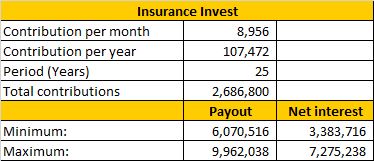
Basic terms of an insurance investment product
Basically, if my friend invests Kshs 8,956 every month for 25 years, he can expect to get between 6 million and 10 million bob at the end of that period. If you subtract the amount he will have invested, it comes to an interest (gain) on his investment of between 3 million and 7.2 million. The rate of return varies, but the document states an expected return of 10%. It does not guarantee this though. It also states that after year 5, he can withdraw limited amounts. It, however, does not state the component of the total return he will lose should he withdraw.
The document has another section that seems to require the policyholder to top up his premiums by about 3,400 per month to get inflation protection. For purposes of this discussion, we will ignore that segment, and inflation generally, so that we are comparing similar items. It also has this fancy table below. Showing you how your fund will grow at different return rates.
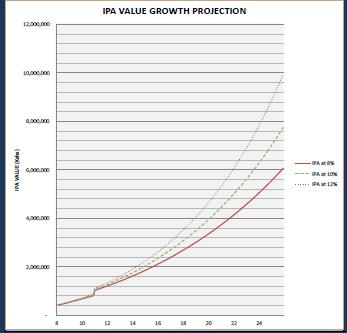
Fund size at different return rates
At face value, it seems like an ok deal. You do make some money, and if your fund performs very well. The cover also comes with other benefits too. To a layman it seems alright. One might argue that since they spend 8,000 bob on a night out anyway, putting it in an insurance scheme like this will be getting him/her a return from cash that would have been wasted anyway – it rarely plays out this way though, we still continue spending on nights out, but reduce our investments in other areas when we sign up for a long term savings scheme. Unless we have a deliberate strategy to cut down our spending.
I want to propose a different plan to save for your kids’ education. It has two components:
1. A whole life insurance cover. This type of cover works similarly to your medical insurance. With a medical cover, you only enjoy the benefit if you get sick. Same way, your beneficiaries get paid only if/when you die with a life cover. It is a pure risk management tool. As long as you keep paying your premiums you are covered, and if you stop, there is no payout.
The advantage of this life cover is that the premiums are much lower than the ones for “Insurance Invest” plan above. This leaves you with some money you can invest in higher-yielding investments. I asked my broker to send me quotations for different amounts of cover, the closest I got to Insurance-Invest was a Kshs 5 million life cover, for which I would pay 4,010 bob per month for as long as I needed the cover.
2. Invest the extra cash. Invest in what? You ask. Now this depends on how active you want to be in your investment. You can buy stocks, bonds or even invest in a business. Each has its knowledge-space and levels of risk.
For purposes of this post, I assumed that you will invest the difference in a 15% (per year) interest-earning investment. For example, the government currently has a 12-year bond that has a rate of 12.5% p.a, last year they issued two that averaged at 14% and 15% respectively according to the CBK website. You can seek advice to combine a bond with a number of blue-chip stocks to get to your desired yield.
The table below shows what will happen to your funds, should you go with the above two options.
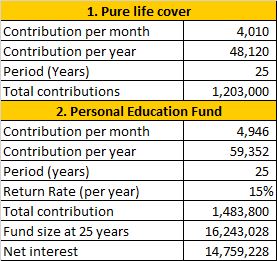
I assumed that you invest at the end of the year, and that the amount compounds monthly, at 15% per year
As you can see above, even if I do not die in the next 25 years and therefore there is no benefit from my life cover, within that time, I will have built a fund that will pay be close to twice what the insurance company would have paid me.
What about if it is for education?
I adjusted the period to 15 years, assuming I need to save for my daughter’s university. My daughter is 4 now, I assumed she goes to university at 19. I fixed the investment amount at Kshs 10,000 per month, since I had the indicative returns data for this from the same insurance company as above.
As you can see below, though the returns improve slightly over a shorter period, you are still leaving close to Kshs 1 million on the table, if you opt for education insurance.
Remember too, that what the insurance company gives you below are indicative returns, they are not guaranteed.
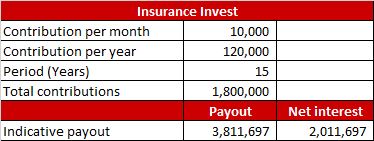
15 year education cover
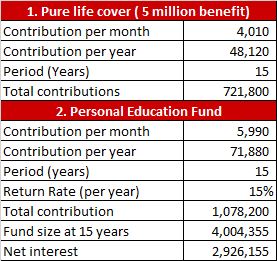
When you own your investment plan
There are no guarantees for either investment, but I feel like we have a better chance of making good returns if we are proactive in our investments.
So what is insurance for?
Any personal finance expert will tell you that insurance is a critical component of any personal finance plan. It is however not a great saving or investment tool. Insurance helps you manage your risks -prevent depletion of your assets should something terrible happen.
We use medical insurance to guard against medical emergencies that could lead us to deplete our savings. Get a decent medical cover, or at least an NHIF cover.
Secondly, we use life insurance to protect our loved ones financially in case we die.
Finally, we use insurance to protect us financially, against loss or damage of our valuable possessions such as cars, household items etc.
In conclusion, insurance is critical and necessary, but be savvy enough to buy the right kind of insurance, not an investment product, masquerading as insurance.
This is the second post in a series about saving for our kids’ education. Read the first post here, and the third post about how to combine your retirement saving, with education saving.
Speaking of savings, I realised that with the #52WeekChallenge , I do not have to set aside money from my usual savings to save for my daughter’s education. All I need to do is reduce my weekly spending by 50 bob every week, to build a fund that will be enough to take her to university. No stress.
We are making savings a daily affair for the next year with M~Shwari. Join the challenge by printing the worksheet and start to save little amounts from your daily spending. We are using the M~Shwari Lock Savings function to track our savings and also stash them away. Do not forget to connect with everyone else on the challenge on our Telegram Group on Twitter where we chat about this constantly using the hashtag #52WeekChallenge .




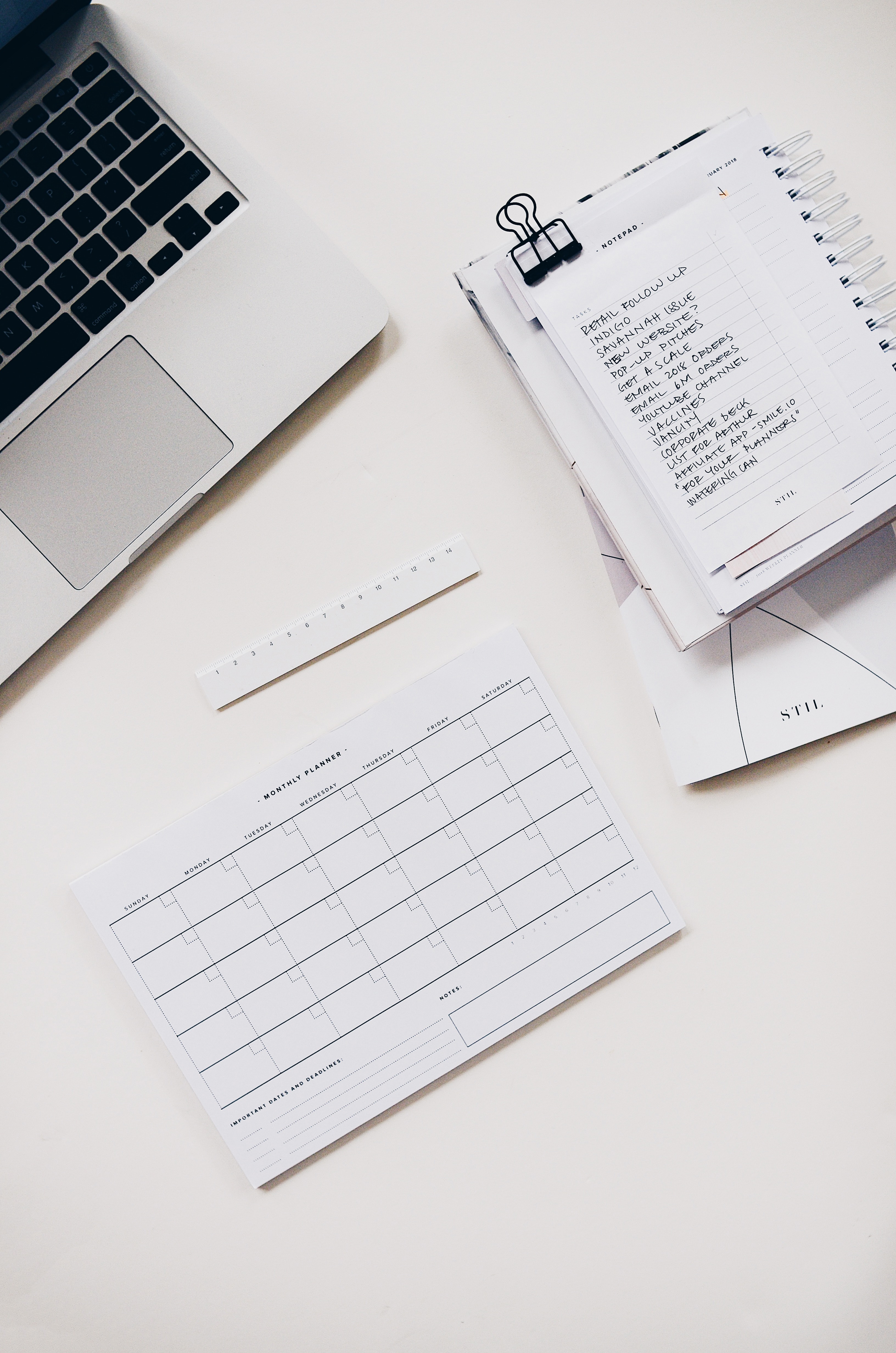

18 Comments